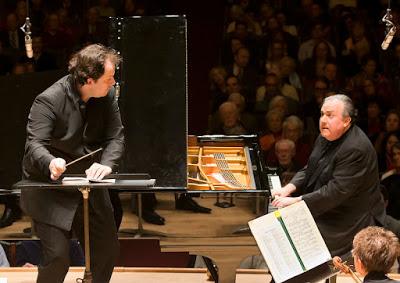by Paul J. Pelkonen
Sale of the Century: Andris Nelsons (left) and Yefim Bronfman storm through Bartók.
Photo by Winslow Townson for the Boston Symphony Orchestra.
This is Andris Nelsons' second year at the helm of the BSO, and the young, energetic maestro is really coming into his element. The concert opened with a special tribute to former BSO concertmaster Joseph "Joey" Silverstein, who had died earlier in the week. The string players took the stage with Mr. Nelsons, offering Bach's Air on a G String in tribute to their former leader. Mr. Silverstein was more than a violinist; he was the teacher of many of the section members, and their tribute was simple, heartfelt and affecting.
Mr. Nelsons then resumed the stage, opening the concert proper with Haydn's rarely programmed Symphony No. 30, nicknamed the Alleluia. Mr. Nelsons brought a crisp, starched texture to these three movements, leading strings and woodwinds in a performance that captured Haydn's signature blend of classical structure and wry good humor. Unusually, this three-movement work ends with a galant minuet, which showed the woodwinds to good effect.
Bartók wrote the Second Piano Concerto for himself to play as a touring musician. With its focus on counterpoint it was meant to be less terrifying than the First. Like its older brother, this work is technically demanding: a formidable piece that continues its creator's habit of treating the piano as a percussive instrument. Yefim Bronfman brought both power and lyricism to the thunderous first movement, working in close concert with Mr. Nelsons. This was a thrilling rendition that burst with energy and vitality, the staccato rhythms of the first movement echoing against taut chords from the winds and a firestorm of percussion.
The strings are mute for the first movement but return in the second, accompanying the piano part and engaging in dialog with the solo instrument. The finale was all joyous, bustling energy, with Bartók's fearless use of folk rhythms creating a propulsive perpetual motion. Mr. Bronfman and Mr. Nelsons locked in together in this final movement which uses material from the opening pages played both inverted and retrograde. And yes, that's musician-speak for backwards and upside-down.
Mr. Bronfman played his guts out in the concerto but gave an encore anyway: a lyric and gentle performance that could not have been more of a contrast with the ferocious Bartók. After intermission, he took a seat in the audience for the symphony that followed: Tchaikovsky's First. Subtitled "Winter Daydreams", this is one of the Russian composer's most appealing creations, crossing uniquely Russian folk-like melodies with gauzy impressions of winter roads, fireplaces, gloaming mists and in the third movement, happy, dancing peasants.
Although this symphony is ignored for the hand-wringing of the Fourth, the bombast of the Fifth and the drama of the Pathetique it is nevertheless a worthy work and an early example of Tchaikovsky's appealing gift for melody. That was apparent from the leading motif, played appealingly by the winds and strings of the BSO. The slow second movement seemed to drift and lift like a bank of fog, bringing a chill to the air that was dissipated by the energy of the Scherzo. That chill returned with the lugubrious opening of the finale, followed by a bright and merry tune that brings the work home in a glittering, whirling fall of aural snow.



